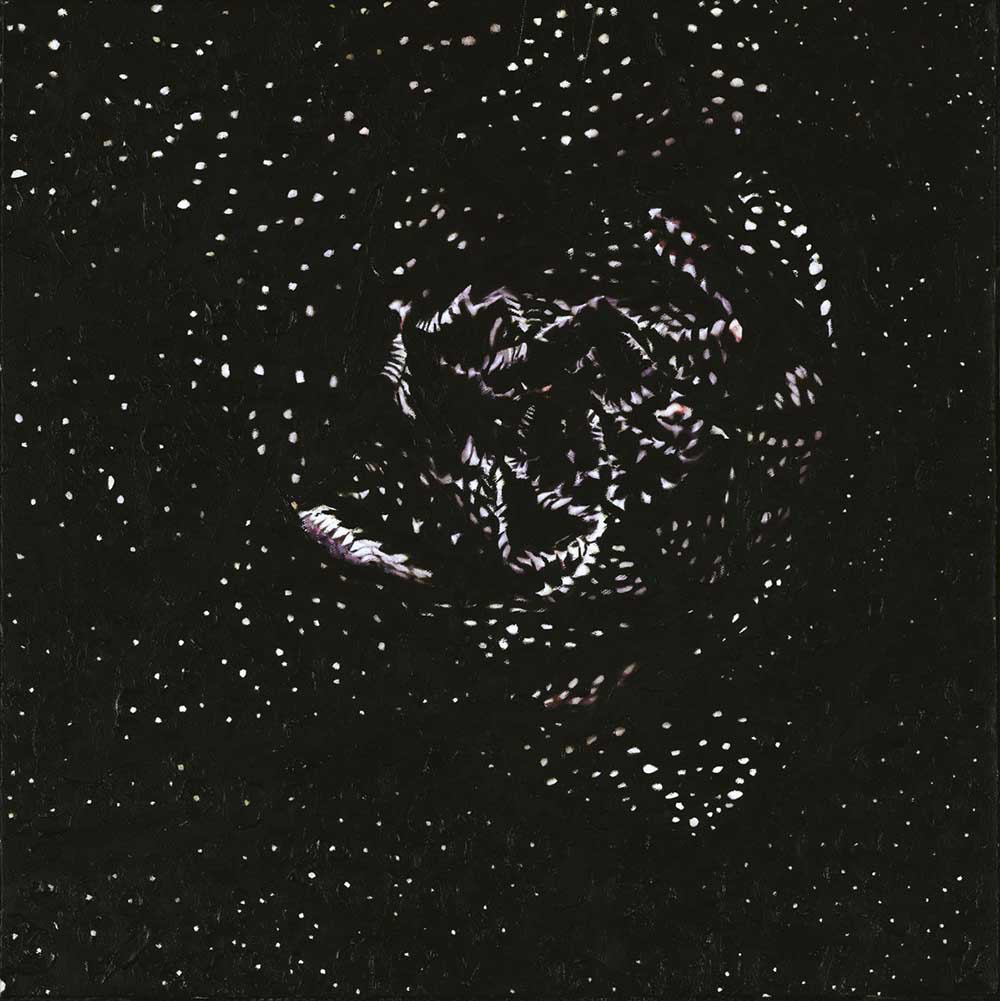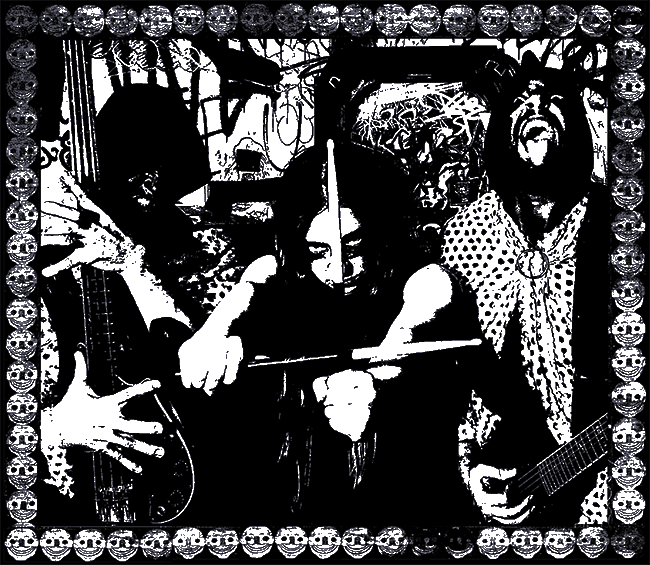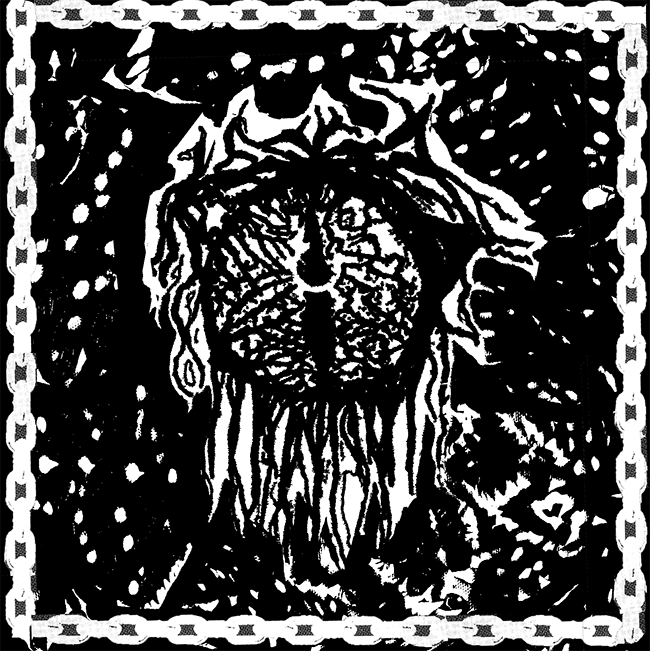Antediluvian
2021-09-22
by Niklas Göransson
The Satan speaks in tongues; scrutinising scripture and the bane of giants with Haasiophis of Canadian black metal monolith Antediluvian.
This is an excerpt from the full article, which is twice as long and published in Bardo Methodology #7. The same issue also includes conversations with BLACK WITCHERY, GOSPEL OF THE HORNS, MACABRE OMEN, THORYBOS, ATLANTEAN KODEX, MGŁA, Cold Meat Industry, Mortiis, MONUMENTUM, WARLOGHE, ORDO TEMPLI AETERNAE LUCIS, and HEXVESSEL.

– Bear in mind that I have a real affinity for late 80s and early 90s black and death metal, then take into account my ingrained personal taste for certain moody music passages and you have ANTEDILUVIAN. I founded this project with the mindset that the true essence of black metal is originality. Not random fucking around, but rather a uniqueness attempting to push the bar further while still considering and remaining fully aware of its environment and the context out of which it was birthed. A set of forms not only prepared to explore new territory, but also recognising and engaging with the legacy of what came before: a genre primarily consisting of unique explorations into unpredictable, bizarre, and otherwise ignored musical territories. The first wave of black metal – bands like CELTIC FROST, BATHORY, and MERCYFUL FATE – sounded nothing alike, but all of them played harsh and boundary-pushing music that both acknowledged their predecessors and expressed a certain kind of ideology. Such manifestations have occurred in waves, and this is the way all black metal bands with integrity do it.
An in-depth discussion about the unique and innovative music of ANTEDILUVIAN will be published at a later date. In the present conversation, we focus more on the project’s conceptual aspects.
– For as long as I remember, I’ve been fascinated by mysteries… archaeology, mythology, ancient civilisations, as well as the shunned parts of this existence: strange creatures, reptiles, dinosaurs, cryptids, undersea dwellers, and the things that crawl in the shadows. The abhorrence most humans feel towards these aspects of reality never had any bearing over me, only fascination. As I studied history, myths, religions, and so forth, I was struck by the recurring parallel about how ‘others’ – adversarial entities, the ‘bad guys’, the punished, and the unforgiven – were said to have challenged, shaped, and enriched the course of humanity. Often via conflict and negativity, sometimes by offering boons of forbidden fruit and knowledge.
What do you think drew you to these matters?
– It’s hard to describe; this is one of the deepest intuitive pulls I’ve ever felt in my life. Contemplating this in the context of everything I know now, I think my obsession is with truth. I was around hunting and fishing a lot when I was a kid and always wanted to look inside the animals that were caught, to find out what was really going on beneath the surface. I think it’s the same attraction. Just because many find it repulsive, is it really ‘bad’? No, it’s a necessary part of life. In order to know who we truly are, we must look beyond the realms of comfort and familiarity. Not just at the strangeness and darkness within our individual selves but also into our past, on the whole scale of humanity, and constantly question whether we know the truth about what brought us to this point.
In 2005, Haasiophis enrolled in a part-time general arts course at an Ontario university. As part of his studies, he also had the chance to take archaeology classes.
– Interestingly, in our very first lecture, the instructor gave an overview of the history of archaeology and talked about Plato’s Atlantis, citing both Timaeus and Critaeus. He also mentioned Schliemann and Troy as an example of how mythology can be used to locate actual historical sites; how it works to at least have an informed dialogue going between legends and lore and the practical, logistical side of things. Not quite the demonised version of an academic someone like John Anthony West would typically project. The major paper I wrote for this class was a summary of the Great Pyramid at Giza.

The following year, Haasiophis relocated to Edmonton, Alberta, to study full-time for a Bachelor of Fine Arts, specialising in printmaking and drawing. As his electives, he chose anthropology, palaeontology, art history, and religious studies; all topics which were heavily infused into ANTEDILUVIAN, the band he and drummer Mars Sekhmet formed the same year. In addition to its general meaning as something archaic, primordial, or from great antiquity, the term ‘antediluvian’ refers to the biblical time between the fall of man – meaning, humanity’s expulsion from Paradise – and the great flood with which God purged mankind.
– In a sense, it can be seen as a reference to stories describing interventionist-type activities. Take for example Genesis 6:4 in the Old Testament – it speaks of crossbreeding between humans and ‘bene ha elohim’, which translates literally to ‘Sons of God’. These trans-dimensional entities, sometimes identified as angels, are being punished by God for a sin of sexually transgressive nature. Meaning, intercourse with human females. This is supposed to have happened in antediluvian times, ‘before the flood’. This subtext recurs, or is referred to, many times throughout scripture. It’s a bizarre undercurrent that’s come to shape the entire story of how and why the Israelites were able to invade and claim the ‘Promised Land’ at the behest of their Old Testament God. It can be surmised that there’s since been a deliberate effort by later curators of the Hebrew Bible to downplay the outright strangeness of this storyline. One reason why the non-canonical Book of Enoch is said to have been expelled from the Jewish canon is because of its in-depth depiction of these events.
‘Non-canonical’ in this context refers to early Jewish and Christian texts which are not part of either religion’s canon: the officially sanctioned holy scriptures. There are hundreds of such books, with some of the most known and best-preserved being the Dead Sea Scrolls, found in the caves of Qumran in the Judean Desert, and the Gnostic Scriptures unearthed in Nag Hammadi, Egypt. During the first few centuries of Christendom, there were many different sects that all had their own preferences for which writings were considered divinely inspired. Debate effectively ended in 367 AD, when Bishop Athanasius of Alexandria issued a list of the twenty-seven books approved by the Catholic Church – a collection that would become known as the New Testament.
– What we call ‘the bible’ today consists both of the religious texts the Jews use – the Hebrew Bible, or Tanakh, also known as the Old Testament – and the Christians’ own addition, the New Testament, written between year 1 and 300 AD and then canonised in the late 4th century. There is no concrete information available on the canonisation of the Hebrew Bible; however, it’s said to have occurred at some point between 150 BC and 200 AD, perhaps under the Hasmonean dynasty. Besides the typical bible texts used today by Christians and Jews, I’ve also read many secondary sources on Qabalah as well as all the apocryphal texts such as the Dead Sea Scrolls and the Gnostic Scriptures. While it’s highly unlikely to come as a surprise to anyone who’s actually studied satanism and the occult, or looked at the bible in an academic context, most Christians are completely unaware of how prevalent this ‘bene ha elohim’ narrative is through both the Old and New Testament. Not to mention the writings which were edited out of the canonical bible, such as the Book of Enoch.
The First Book of Enoch purports to be the autobiography of the great-grandfather to Noah, of the Ark fame. Enoch is mentioned in both the Old and New Testament, and it is known that the book was studied in several different countries before Jesus Christ ever walked the earth. It was presumably written in Hebrew, but no known copies have survived. With only fragments quoted and referred to in ancient sources, theologians long believed the book to have been lost entirely. However, upon returning to Europe in 1773, after many years exploring Africa, the Scottish adventurer James Bruce carried with him three complete copies. Bruce acquired them in Ethiopia, where the Book of Enoch had been part of the canon of isolated communities of Ethiopian Jews and Christians for at least a thousand years, and still is to this day. Once it had been translated from Ge’ez, or Classical Ethiopian, scholars were able to positively identify the book as genuine by comparing translated passages to quotations from older source material. The Book of Enoch has 108 chapters, the first thirty-six of which are called the Book of the Watchers and contain divine secrets revealed to Enoch during some kind of visionary trance state. Two hundred of these Watchers, the bene ha elohim, were stationed on Earth by the Almighty, charged with keeping a vigilant eye over humanity. Not entirely sold on the concept of celibacy, the Sons of God soon started lusting after the daughters of man, to the extent where they deserted their posts and took mortal mates. The Watchers further transgressed against God by teaching mankind in the ways of science, art, medicine, and the occult. In fact, the book offers a detailed index describing which Watcher taught what subjects, with about twenty of them named. Following what Enoch 8:2 describes as ‘great wickedness and much fornication’, the union between human and angel birthed a race of giants known as the Nephilim – a savage breed, said to have turned against both mankind and the very earth. These are the same giants mentioned in the Old Testament’s Book of Genesis, which tells the story of Noah’s Ark. With humanity corrupted by forbidden knowledge, rogue angels on the loose, and now also the Nephilim nuisance, God has had enough and sends a deluge to wipe out the lot of them. Prior to this, Uriel, an archangel still loyal to God, warns Noah about the impending cataclysm, allowing him to take precautions by building an ark. However, Old Testament passages like Numbers 13:33 indicate that some of the Nephilim escaped the flood and remain involved in mankind’s affairs.
– At a casual glance, tales of fallen angels impregnating human females all seem quite outlandish. Sure, it’s entertaining and weirdly fascinating, just like the Ancient Aliens television show, but must obviously be taken with a grain of salt. There’s no official archaeological record that undoubtedly points to extra-terrestrial involvement in human affairs, so it’s all open to interpretation. Do Christians really believe this part of the bible? Does it have significance to those currently practising Judaism? I can’t answer for these people, but I can infer my own interpretation. Although the Book of Enoch goes into more detail, the story of the Watchers is echoed in Genesis and repeatedly alluded to through the remaining scripture. Why was it so important to include this? If you look at it in a political sense, this interventionist tale of mating with the daughters of men and of their offspring, the Nephilim, provides moral justification for the Hebrew invasion and subsequent extermination of the people of Canaan – what they thought of as the Promised Land.
After Moses liberates the Israelites from slavery and leads them out of Egypt, as narrated in the Book of Exodus, they arrive at the borders of Canaan, a country stretching over soil today claimed by Jordan, Israel, Syria, and Lebanon. As luck would have it, thousands of years earlier, God promised the first Patriarch of the Jews, Abraham, that this very land would belong to his seed for eternity. Now, as implied by its name, Canaan was already populated by a people known as the Canaanites. One of the few historical accounts of them is found in the Old Testament, where they have the distinct misfortune of being mentioned as one of six civilisations God wants ‘devoted to complete destruction’. Before they proceed, Moses dispatches twelve spies to survey the realm. Upon their return, after forty days and forty nights, ten of them describe the terrain itself as ‘flowing with milk and honey’, but claim the Israelites would stand defenceless against the Canaanite populace.
All the people we saw there were of great size. We saw the Nephilim there. We seemed like grasshoppers in our own eyes, and we looked the same to them.
The many identical reports are considered credible by the Israelite community, whose collective hearts sink. Big mistake. Unbeknownst to them, speaking negatively about a territory promised by the Lord qualifies as slandering the Holy Land. To say that God is wroth would be an understatement; after killing the ten defamatory spies by way of plague, He sends the entire host of Israelites out to wander the desert for forty years. By the end of it, every male from the unfaithful generation has perished, save for Joshua and Caleb – the two spies who gave positive reports. Joshua leads the Israelites out of the desert and into Canaan where they fall upon the city of Jericho, leaving behind them not a single heart still beating. As for historical records, there is nothing to corroborate either slavery in Egypt or the four-decade desert foray, but, based on archaeological evidence of the destruction of Canaanite cities as well as the complete cessation of their culture, scholars estimate an Israelite invasion took place around 1250 BC. The Hebrew Bible describes how Joshua takes particular care to purge the land from Anakim, a race of giants said to have descended from the Nephilim. However, despite his best genocidal efforts, a few Anakim survive and take flight to the cities of Gaza, Gath, and Ashdod. Once Canaan is subjugated and renamed the Kingdom of Israel, the Israelites finally have their Promised Land.
– The entire Old Testament is the continued story of the struggle of these people coming out of the desert and gaining a foothold in a foreign place that God has told them was their rightful duty to seize from its current inhabitants. The Book of Joshua describes the beginning of this and, paying close attention to the etymology, one notices that tribes bearing names ending with the suffix ‘im’ – Ankim, Rephaim, Gibborim, and so on – are said to either have been giants or had giants living among them. It is implied they are remnants of Nephilim offspring and that it’s perfectly okay to not just defeat them but, in some cases, completely wipe out every man, woman, child, and animal because they’re all part of this corrupted inhuman lineage. Further down the timeline, we find another such group: the Philistines, main enemies of the Israelites during the territorial wars of King Saul and King David. And who was their champion? Goliath, the giant.
The Book of Samuel tells the well-known tale of David and Goliath, which has since become a common metaphor for underdog struggles. Saul, the first king of Israel, is warring against an enemy tribe known as the Philistines when a champion called Goliath – described as a giant from Gath, one of the cities the Anakim remained in – emerges to challenge any Israelite to single combat. Famously, the future King David heeds the call and bests Goliath by hurling a stone in his forehead with a slingshot, then beheading him as he tumbles over.
– The word Philistine is the origin of what we today call ‘Palestine’, though whether the biblical Philistines were predecessors of modern-day Palestinians is not confirmed. Regardless, the same kind of demoralising and destabilising tactics are still being employed to this day. In July 2019, Israeli prime minister Benjamin Netanyahu cited a recent archaeological study of DNA from a Philistine site which showed that their origins were southern European. Palestine’s population is Arab so, according to Netanyahu, that rules out any connection with the biblical Philistines – essentially implying that today’s Palestinians have no ancestral claim to the land. Palestinian journalists, on the other hand, warn that such comments are precisely what the UN describes as ‘early warning signs of genocide’. Whether the interventionist story is true or not doesn’t matter from a political perspective, but for millennia it has served well as a reinforcement of this warlike mindset of cultural bias and prejudice. In that sense, it really spins the head to consider… two to three thousand-year-old writings in the bible begin a tale of psychological warfare, dehumanisation, conquest, and justification of an ethnic cleansing that we can still read about in the papers today.

This was an excerpt from the full article, which is twice as long and published in Bardo Methodology #7. The same issue also includes conversations with BLACK WITCHERY, GOSPEL OF THE HORNS, MACABRE OMEN, THORYBOS, ATLANTEAN KODEX, MGŁA, Cold Meat Industry, Mortiis, MONUMENTUM, WARLOGHE, ORDO TEMPLI AETERNAE LUCIS, and HEXVESSEL.



